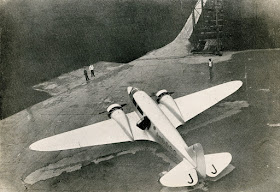1:72 Nakajima J9N2-S “Kikka” (橘花), aircraft “(51-)03” of the Imperial Japanese Navy’s 251st Kokutai; Kumamoto airfield (Kyushu, Japan), early 1946 (Whif/modified AZ Models kit)
The kit and its assembly:
This is a J9N two-seater from AZ Models – it is the trainer boxing but converted into a fictional night fighter. The AZ Models kit is a simple affair, but that's also its problem. In the box things look quite good, detail level is on par with a classic Matchbox kit. But unlike a Matchbox kit, the AZ Models offering does not go together well. I had to fight everywhere with poor fit, lack of locator pins, ejection marks, anything a short run model kit can throw at you! What worked surprisingly well was the clear IP canopy, though, which I cut into five sections for an optional open display. However, I am not certain if the kit’s designers had put some brain into their work because the canopy’s segmentation becomes more and more dubious the further you go backwards: the rear hatch is only pygmy size at best!
Personal mods include a slightly changed armament, with one nose gun deleted and faired over with a piece of styrene sheet, while the leftover gun was moved to the left flank, firing obliquely. I initially considered a central position behind the canopy but rejected this because of CoG reasons. Then I planned to mount it directly behind the 2nd seat, so that the barrel would protrude through the canopy’s last segment, but this appeared unrealistic because the (utterly tiny) sliding canopy for the rear crewman could not have been opened anymore? Finally, I settled for the offset position in the aircraft’s flanks, partly inspired by “Schräge Musik” arrangements on some German Fw 190 night fighters. The antenna array comes from a Jadar Model PE set for Italeri’s Me 210s – chosen on the basis of descriptions of the FD-2 radar that was used on other Japanese night fighters of the late WWII era.
Painting and markings:
This became rather lusterless, with the intention of a realistic look and feel for this what-if model. Many late IJN night fighters carried a uniform dark green livery with minimalistic, toned-down markings, including hinomaru without a white high-contrast edge. Just the yellow ID bands on the wings’ leading edges were retained.
For this scheme the model received an overall basis coat of Humbrol 75 (Bronze Green), later treated with a black ink washing, post-shaded with lighter shades of dark green (including Humbrol 116 and Revell 67) and some dry-brushed aluminum. The only colorful highlight is a red fin tip (Humbrol 19) and a thin red stripe underneath (decal). The yellow and white ID bands were created with generic decal material (TL Modellbau).
The cockpit interior was painted in a yellowish-green primer (trying to simulate a typical “bamboo” shade that was used in some late-war IJN cockpits), while the landing gear wells were painted in aodake iro, a clear bluish protective lacquer. The landing gear struts themselves became semi-matt black.
The markings are fictional and were puzzled together from various sources. The hinomaru came from the AZ Models’ Kikka single seater sheet (it offers six roundels w/o white edge), the tactical code on the fin was created with red numbers from a Fujimi Aichi B7A2 Ryusei. Stencils and victory markings come from a PrintScale 1:72 Mitsubishi J2M sheet.
Finally, the simple model received a coat of matt acrylic varnish and some grinded graphite around the jet exhausts and the gun nozzles.
- Dizzyfugu -































